Weekend Wanderlust: Matera, Italy's city of caves, contrasts, and culture
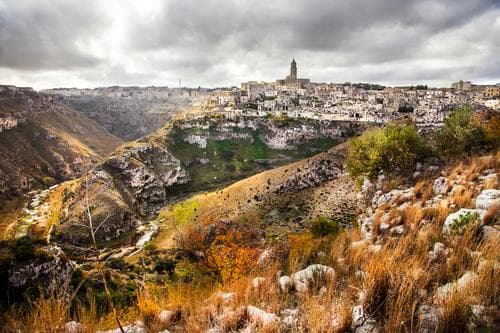
The third-oldest city in the world, Matera is in the limelight in 2019 but it has an enduring, timeless appeal that few travellers will be able to resist. Here's what The Local's editor Clare Speak made of it on a recent weekend visit.
It was surprising to read in the New York Times recently that Matera’s mayor doesn’t want tourists.
“We don’t want to be occupied by tourists,” he said. Tourism will "deplete the city of its soul."
His statement wasn’t just surprising because mayors aren’t supposed to say things like that, or because it was so futile – tourist numbers have already jumped by 216 percent here since 2010.
It was more surprising because it went against everything I know about the open, friendly people of Matera.
“In Matera you’re a guest, not a tourist,” insisted Giuseppe Bartucci, who grew up and lives in the city, where he works as a tour guide alongside his full-time job.
Standing in front of the grand municipal library, we could barely move for the crowds jostling to photograph part of a Dali exhibition, the sculpures standing in stark contrast with their historic surroundings.
When I asked if tourism caused problems for people living in Matera, Giuseppe just shrugged: “It makes some things more expensive.” But as far as he and many other residents are concerned, it’s not a problem.
Either way, the tourists keep coming. The third-oldest city in the world, Matera is today one of Italy’s hottest travel destinations; a UNESCO heritage site about to celebrate its year as European Capital of Culture, beginning on January 19, 2019.
Natural openness and curiosity about other people is part of the way of life in Matera, Giuseppe tells me - and perhaps that’s no surprise when you consider how people here lived until just over 60 years ago.
With roads, gardens and even cemeteries built on top of churches built on top of houses, from above, Matera’s old town, or Sassi, looks like a chaotic jumble.
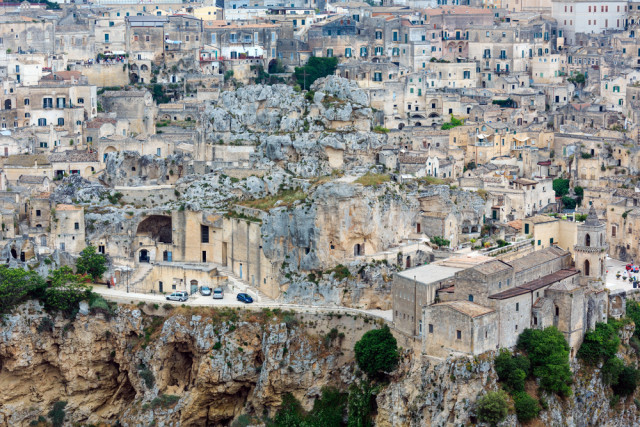
Photo: Depositphotos.
It’s hard to tell where one building ends and another begins. But after walking the streets for a while, you start to understand that there is plenty of logic to it.
Every bit of space had been put to good use. And not only were the homes built around small communal squares with shared wells and cooking facilities, but on closer inspection, you’ll see that the cave homes themselves, dug by hand from the soft stone, have a remarkably sophisticated design.
Dug out at just the right angle to make full use of any sunlight in winter, and keep as cool as possible in summer, the cave homes are a chain of rooms, each slightly lower than the next. The excavated stone was used to build a simple facade - but doors are a recent addition.
Their inhabitants also created sophisticated underground cisterns under every home, which trapped rainwater and stopped it from evaporating.
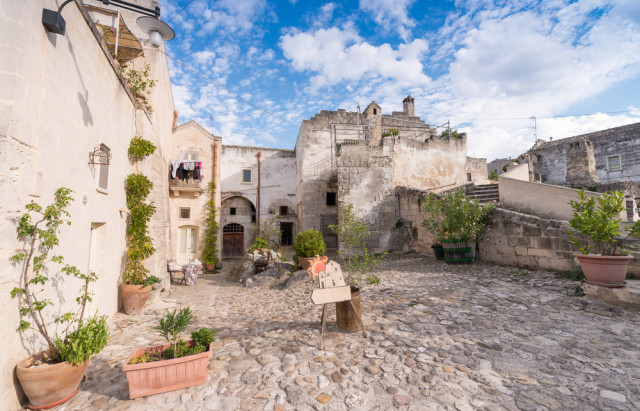
Photo: Depositphotos.
Matera is known for once being “Italy’s shame.” The government intervened in the 1950s, passing a law that forced residents out of the Sassi and into modern housing after squalid, overcrowded living conditions were discovered.
But until the 1930s, Giuseppe explains, things were not like that at all. There was more space, animals had their own quarters, and the city had decent sanitation, with a kind of sewer running down channels in main roads.
But when that sewer was paved over, people had little choice but to empty chamber pots into the street. Disease spread. And as the city’s population exploded, in a space with natural limitations, there was less room for everyone and soon animals had to share space with the family.
The town and its inhabitants were in a shocking state by the time writer Carlo Levi arrived in the 1930s, after being exiled from his home in Turin and sent to a tiny Basilicata village by the fascist government.
Levi described dirty, impoverished conditions in the cave houses and malaria-ridden children in front of the cathedral begging for quinine. He compared the Sassi, tumbling downwards into the Gravina, with Dante’s vision of hell.
Despite Matera being an important town, and the seat of local government, distant authorities in Rome had no idea it had fallen into this state until Levi, returning from his exile years later, sounded the alarm.
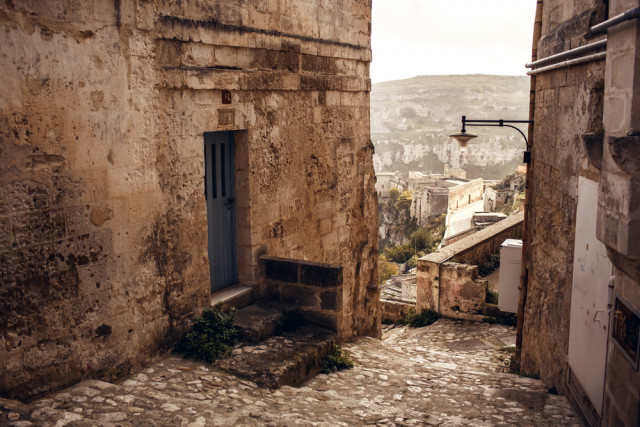
Photo: Depositphotos
“Old people didn’t like it, but most other people saw it as a new start,” says Giuseppe, of the forced move to more modern housing.
But adjusting to this new, modern way of life was still a challenge for very social people used to living very literally on top of one another, with a curtain for privacy at the most.
“Materans are countryside people who like a simple life. People still leave their doors open in some parts,” says Piero Manicone, bartender at Aquatio, the newest and possibly the shiniest of all Matera’s polished high-end hotels, which have transformed many of the city’s former cave dwellings into luxury suites.
Piero grew up here in Matera and has witnessed its rapid transformation up close. He clearly remembers when the luxurious, gleaming white space he now works in was an abandoned cave house, little more than a dark hole in the earth, where he and his friends played as children.
On the plain above the Sassi, central Matera has grand baroque and liberty style buildings with Mussolini-era and more modern architecture dotted throughout. The contrast between the many architectural styles, colours and textures is striking.
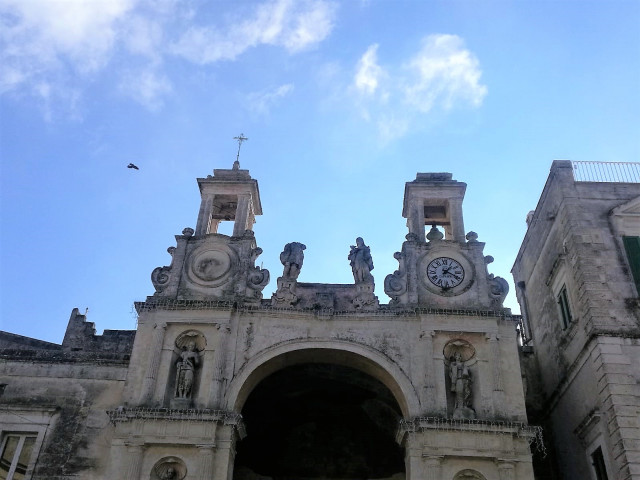
Photo: Clare Speak/The Local Italy
We walk away from the centre in search of lunch at one of Giuseppe’s local haunts, Ristorante Rivelli. It has just relocated to modern premises, by the Sassi Caveoso.
The food however is rustic Cucina Lucana, with recipes perfected over decades, if not generations.
We feast on rich, buttery trofie – thick, short strands of pasta – with prawns, zucchini and mushrooms. We crunch our way through plates of sun-dried and flash-fried red peppers with a deep, smoky flavour.
After a tagliata of meltingly tender T-bone steak, a basket of famous Materan bread and a bottle of intense, spicy L'Atto from local Cantine del Notaio, I’m afraid I might not be able to walk.
I’m surprised to have been faced with such a mountain of delicious food, since Matera doesn’t have the best food reputation. It is true that restaurants here, like elsewhere, can be hit and miss. “A lot of people are opening B&Bs and restaurants when they have no experience of the industry,” Giuseppe explains.
But there are enough hits. As well as Rivelli, there’s the highly-acclaimed Dimora Ulmo, and even in the most-touristed streets you can find a decent meal if you’re careful. It's not exactly Venice, and most businesses are owned and staffed by local people.
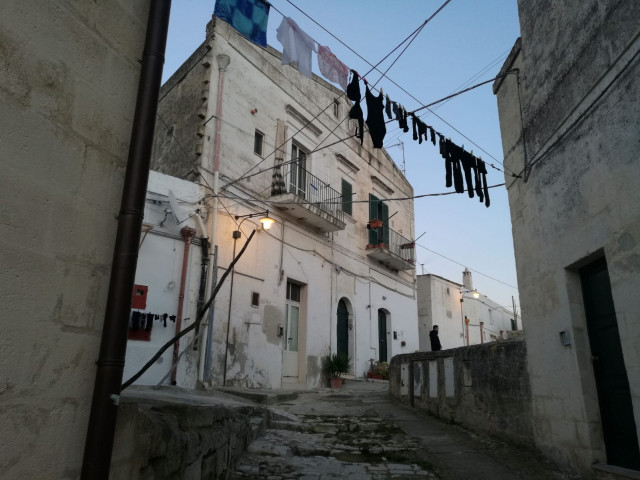
Photo: Clare Speak/The Local Italy
Many people have reclaimed and renovated the former cave houses that were abandoned by their grandparents, usually turning them into businesses. But the Sassi are far quieter today than they were in Levi’s day, since very few people actually live there.
“It’s not practical for everyday life. You have to park far away, you have to walk a long way to get to a supermarket,” says Giuseppe who, like most Materans, lives in the modern part of town.
An entire old town full of B&Bs and luxury hotels might give the idea that the Sassi has become a soulless ghetto given over entirely to mass tourism. But it’s not the case.
While some main streets are slowly losing their character to tourist shops, the Sassi are still full of a bewitching atmosphere, older than time.
There are expanses of the Sassi where all or most of the houses stand stricken and completely abandoned, untouched since the 1950s.
The occasional string of washing hung out to dry above the street lets us know a house is inhabited, but they're few and far between, flanked by abandoned buildings.
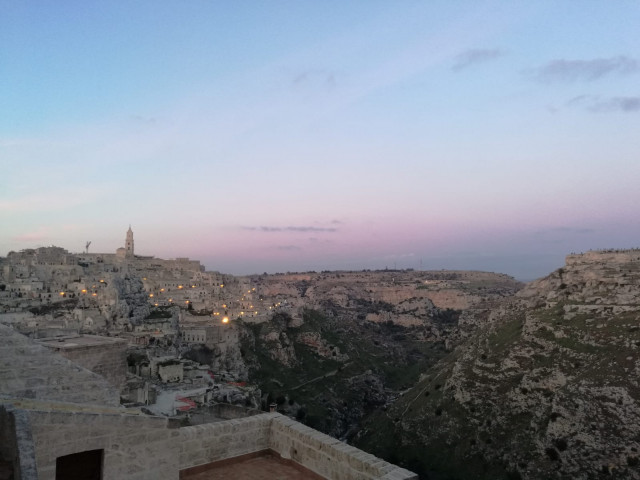
Photo: Clare Speak/The Local Italy
In the Sassi Barisano, Giuseppe shows me streets with entrances either bricked up or staring out like empty black eyes over the ancient Gravina below.
“Two thirds of these houses are still state property, and for now you can’t buy them,” Giuseppe explains.
And maybe that’s for the best, as for now there’s no sign of tourism “depleting” Matera’s prehistoric soul, as the mayor apparently fears.
At night here it becomes still. If you stay overnight you’ll find that once the crowds leave, the Sassi, like the Gravina below, is covered in a thick silence. Piero compares walking in the silent Sassi to going for a massage.
It’s not easy to understand Matera’s complex and ancient history or see all of its sights on a short visit. And no matter how often I return, there never seems to be enough time.
But whether you’ve got a few hours or a couple of days, Matera is the kind of place that needs to be seen to be believed, and it deserves every bit of the hype.
Comments
See Also
It was surprising to read in the New York Times recently that Matera’s mayor doesn’t want tourists.
“We don’t want to be occupied by tourists,” he said. Tourism will "deplete the city of its soul."
His statement wasn’t just surprising because mayors aren’t supposed to say things like that, or because it was so futile – tourist numbers have already jumped by 216 percent here since 2010.
It was more surprising because it went against everything I know about the open, friendly people of Matera.
“In Matera you’re a guest, not a tourist,” insisted Giuseppe Bartucci, who grew up and lives in the city, where he works as a tour guide alongside his full-time job.
Standing in front of the grand municipal library, we could barely move for the crowds jostling to photograph part of a Dali exhibition, the sculpures standing in stark contrast with their historic surroundings.
When I asked if tourism caused problems for people living in Matera, Giuseppe just shrugged: “It makes some things more expensive.” But as far as he and many other residents are concerned, it’s not a problem.
Either way, the tourists keep coming. The third-oldest city in the world, Matera is today one of Italy’s hottest travel destinations; a UNESCO heritage site about to celebrate its year as European Capital of Culture, beginning on January 19, 2019.
Natural openness and curiosity about other people is part of the way of life in Matera, Giuseppe tells me - and perhaps that’s no surprise when you consider how people here lived until just over 60 years ago.
With roads, gardens and even cemeteries built on top of churches built on top of houses, from above, Matera’s old town, or Sassi, looks like a chaotic jumble.

Photo: Depositphotos.
It’s hard to tell where one building ends and another begins. But after walking the streets for a while, you start to understand that there is plenty of logic to it.
Every bit of space had been put to good use. And not only were the homes built around small communal squares with shared wells and cooking facilities, but on closer inspection, you’ll see that the cave homes themselves, dug by hand from the soft stone, have a remarkably sophisticated design.
Dug out at just the right angle to make full use of any sunlight in winter, and keep as cool as possible in summer, the cave homes are a chain of rooms, each slightly lower than the next. The excavated stone was used to build a simple facade - but doors are a recent addition.
Their inhabitants also created sophisticated underground cisterns under every home, which trapped rainwater and stopped it from evaporating.

Photo: Depositphotos.
Matera is known for once being “Italy’s shame.” The government intervened in the 1950s, passing a law that forced residents out of the Sassi and into modern housing after squalid, overcrowded living conditions were discovered.
But until the 1930s, Giuseppe explains, things were not like that at all. There was more space, animals had their own quarters, and the city had decent sanitation, with a kind of sewer running down channels in main roads.
But when that sewer was paved over, people had little choice but to empty chamber pots into the street. Disease spread. And as the city’s population exploded, in a space with natural limitations, there was less room for everyone and soon animals had to share space with the family.
The town and its inhabitants were in a shocking state by the time writer Carlo Levi arrived in the 1930s, after being exiled from his home in Turin and sent to a tiny Basilicata village by the fascist government.
Levi described dirty, impoverished conditions in the cave houses and malaria-ridden children in front of the cathedral begging for quinine. He compared the Sassi, tumbling downwards into the Gravina, with Dante’s vision of hell.
Despite Matera being an important town, and the seat of local government, distant authorities in Rome had no idea it had fallen into this state until Levi, returning from his exile years later, sounded the alarm.

Photo: Depositphotos
“Old people didn’t like it, but most other people saw it as a new start,” says Giuseppe, of the forced move to more modern housing.
But adjusting to this new, modern way of life was still a challenge for very social people used to living very literally on top of one another, with a curtain for privacy at the most.
“Materans are countryside people who like a simple life. People still leave their doors open in some parts,” says Piero Manicone, bartender at Aquatio, the newest and possibly the shiniest of all Matera’s polished high-end hotels, which have transformed many of the city’s former cave dwellings into luxury suites.
Piero grew up here in Matera and has witnessed its rapid transformation up close. He clearly remembers when the luxurious, gleaming white space he now works in was an abandoned cave house, little more than a dark hole in the earth, where he and his friends played as children.
On the plain above the Sassi, central Matera has grand baroque and liberty style buildings with Mussolini-era and more modern architecture dotted throughout. The contrast between the many architectural styles, colours and textures is striking.

Photo: Clare Speak/The Local Italy
We walk away from the centre in search of lunch at one of Giuseppe’s local haunts, Ristorante Rivelli. It has just relocated to modern premises, by the Sassi Caveoso.
The food however is rustic Cucina Lucana, with recipes perfected over decades, if not generations.
We feast on rich, buttery trofie – thick, short strands of pasta – with prawns, zucchini and mushrooms. We crunch our way through plates of sun-dried and flash-fried red peppers with a deep, smoky flavour.
After a tagliata of meltingly tender T-bone steak, a basket of famous Materan bread and a bottle of intense, spicy L'Atto from local Cantine del Notaio, I’m afraid I might not be able to walk.
I’m surprised to have been faced with such a mountain of delicious food, since Matera doesn’t have the best food reputation. It is true that restaurants here, like elsewhere, can be hit and miss. “A lot of people are opening B&Bs and restaurants when they have no experience of the industry,” Giuseppe explains.
But there are enough hits. As well as Rivelli, there’s the highly-acclaimed Dimora Ulmo, and even in the most-touristed streets you can find a decent meal if you’re careful. It's not exactly Venice, and most businesses are owned and staffed by local people.

Photo: Clare Speak/The Local Italy
Many people have reclaimed and renovated the former cave houses that were abandoned by their grandparents, usually turning them into businesses. But the Sassi are far quieter today than they were in Levi’s day, since very few people actually live there.
“It’s not practical for everyday life. You have to park far away, you have to walk a long way to get to a supermarket,” says Giuseppe who, like most Materans, lives in the modern part of town.
An entire old town full of B&Bs and luxury hotels might give the idea that the Sassi has become a soulless ghetto given over entirely to mass tourism. But it’s not the case.
While some main streets are slowly losing their character to tourist shops, the Sassi are still full of a bewitching atmosphere, older than time.
There are expanses of the Sassi where all or most of the houses stand stricken and completely abandoned, untouched since the 1950s.
The occasional string of washing hung out to dry above the street lets us know a house is inhabited, but they're few and far between, flanked by abandoned buildings.

Photo: Clare Speak/The Local Italy
In the Sassi Barisano, Giuseppe shows me streets with entrances either bricked up or staring out like empty black eyes over the ancient Gravina below.
“Two thirds of these houses are still state property, and for now you can’t buy them,” Giuseppe explains.
And maybe that’s for the best, as for now there’s no sign of tourism “depleting” Matera’s prehistoric soul, as the mayor apparently fears.
At night here it becomes still. If you stay overnight you’ll find that once the crowds leave, the Sassi, like the Gravina below, is covered in a thick silence. Piero compares walking in the silent Sassi to going for a massage.
It’s not easy to understand Matera’s complex and ancient history or see all of its sights on a short visit. And no matter how often I return, there never seems to be enough time.
But whether you’ve got a few hours or a couple of days, Matera is the kind of place that needs to be seen to be believed, and it deserves every bit of the hype.
Join the conversation in our comments section below. Share your own views and experience and if you have a question or suggestion for our journalists then email us at [email protected].
Please keep comments civil, constructive and on topic – and make sure to read our terms of use before getting involved.
Please log in here to leave a comment.